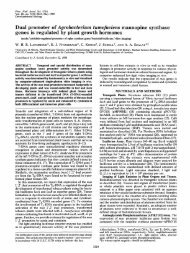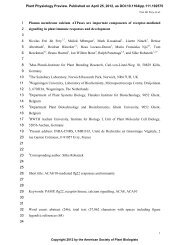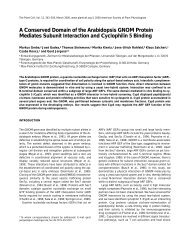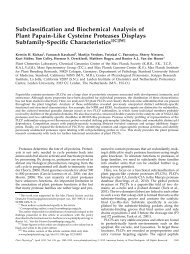1 Transposon and T-DNA mutagenesis
1 Transposon and T-DNA mutagenesis
1 Transposon and T-DNA mutagenesis
Create successful ePaper yourself
Turn your PDF publications into a flip-book with our unique Google optimized e-Paper software.
'<br />
Unstable alb3 mutants, resulting from somatic Ds excision, were found in<br />
progeny of GUS+ (= Ac transposase+) F2 siblings of the alb3 segregating line.<br />
Marking Ds elements by a selectable marker is essential to obtain many<br />
plants that have inherited a Ds after excision. With the 35s-Ac transposase<br />
source, 90% of the hygr/strepr F2 plants contained a transposed Ds (24),<br />
whereas only 50% with the ANaeIsAc transposase source (27). In the other<br />
hygr/strepr plants, Ds excised from only one of two SPT::Ds T-<strong>DNA</strong> alleles,<br />
without subsequent reinsertion.<br />
2.2.3 EnlSpm-IldSpm systems<br />
Based on experiments with tobacco using a wild-type En/Spm element of<br />
maize (28) a one element En/Spm system was developed for Arabidopsis, that<br />
surprisingly gave a much higher transposition frequency as compared to<br />
tobacco or potato or to Ac in Arabidopsis (29). The germinal excision<br />
frequency averaged 7.5% <strong>and</strong> remained constant over a number of generations.<br />
Excisions of En/Spm occurred often independently from each other,<br />
with a high reinsertion frequency. A two element system in which a nonautonomous<br />
dSpm element was activated by two transposase genes, controlled<br />
by CaMV 35s promoters, has not been analysed in detail yet (29).<br />
At the CPRO-DL0 an 'in cis En-I two element system' was developed (30,<br />
31), which harbours both the En transposase source <strong>and</strong> a non-autonomous I<br />
element inserted in a HPT marked T-<strong>DNA</strong>. The expression of the two<br />
transposase genes is controlled by a CaMV 35s promoter fused to a truncated<br />
immobile En element. This system combines the advantages of the one <strong>and</strong><br />
two element systems, having both continuous transposition <strong>and</strong> the ability to<br />
stabilize I elements. One transgenic plant, carrying two loci with multiple T-<br />
<strong>DNA</strong> inserts, was allowed to self-fertilize to generate different populations,<br />
carrying transposed I elements at many different positions. Instead of the<br />
germinal excision frequency, the frequency of independent transposition was<br />
assessed by <strong>DNA</strong> hybridization, as the fraction of unique novel inserts<br />
compared to all I element inserts in the progeny of a certain parental plant.<br />
This frequency varied from 5-10% in progeny of plants carrying over five I<br />
element copies, to almost 30% in progeny of single copy Zelement plants.<br />
2.2.4 Tagging with I elements<br />
In principle every generation of I element-carrying lines obtained after selfing<br />
can be screened for mutants. Outcrossing a mutant with wild-type L<strong>and</strong>sberg<br />
erecta (Ler) for one or two generations will segregate out the transposase<br />
source, help to reduce the number of inserts, <strong>and</strong> yield stable mutants for the<br />
isolation of I element tagged genes.<br />
The En-I was used for tagging <strong>and</strong> isolation of the MS2 (male sterility) gene<br />
(30), <strong>and</strong> others including CERI (eceriferum) (32), LFY (leafy flowers) (M. V.<br />
Byzova, unpublished results), API (apetala), AB13 (abscisic acid-insensitive),<br />
1: 1 mnsposon ana 1 - uvn IIlULU~GlICJJJ<br />
LEC~ (leafy cotyledon) (M. Koornneef, K. Uon-Kloosterziel, <strong>and</strong> A. J. M.<br />
peters, unpublished results), GL2, ANL2 (anthocyaninless) (51), LAD (late<br />
anther dehiscence) (M. A., unpublished results), WIL (wilting) (A. P.,<br />
unpublished results), <strong>and</strong> SAP (sterile apetala). All of these mutants showed<br />
either somatic or germinal reversion in the presence of transposase.<br />
2.3 Which system to use<br />
2.3.1 R<strong>and</strong>om tagging<br />
The use of Ac-Ds systems for r<strong>and</strong>om gene tagging is labour-intensive, because<br />
it requires an in vitro selection for excision <strong>and</strong> reinsertion. Assuming<br />
that 2-4% of all Ds inserts give rise to mutations with visible phenotypes (25,<br />
26), screening 2500-5000 F3 families carrying transposed Ds is expected to<br />
yield about 100 tagged mutants. This may seem a lot, however a saturation<br />
<strong>mutagenesis</strong> in Arabidopsis may require the generation <strong>and</strong> screening of over<br />
100000 inserts in F3 as was estimated by Feldmann (4).<br />
The En-I system seems to be more adapted for r<strong>and</strong>om tagging. With an<br />
independent transposition frequency of 10-30%, it is possible to generate a<br />
large population of different inserts in only a few generatio~s. For example,<br />
starting with a single Mo plant, which harbours a hemizygous En transposase<br />
source <strong>and</strong> ten different I element inserts, at least 10% of all I elements are<br />
expected to reside at a new location in the next generation. There will thus be<br />
on average 1000 different hemizygous inserts in 1000 MI plants. M2 seeds of<br />
these 1000 MI plants can be harvested in bulk. Sowing 12000 bulked seeds<br />
gives a 95% probability of recovering all new homozygous inserts (assuming<br />
equal seed set <strong>and</strong> viability). Theoretically, 100000 different inserts can be<br />
obtained from 10000 M5 plants, when starting with 100 Mo plants (as<br />
unrelated as possible) containing ten I elements at different positions. When<br />
Mo plants hemizygous for the En transposase source are used, on average<br />
37.5% of the M2 plants will have stable homozygous I elements, reducing the<br />
chance of losing mutants that are not distinguishable due to a high excision<br />
frequency. Lines containing transposed I elements will become available<br />
through the seed stock centres.<br />
' 2.3.2 Targeted tagging<br />
An advantage of two element Ac-Ds systems lies especially in targeted gene<br />
tagging. Targeted tagging involves transposon <strong>mutagenesis</strong> of an already<br />
mapped locus. It has been employed in maize, using either linked or unlinked<br />
transposable elements (33,34), <strong>and</strong> recently also in Arabidopsis (35). As with<br />
wild-type Ac in maize (36) most Ds elements transpose to positions genetically<br />
linked to their original genomic location (27). Choosing Ds elements<br />
closely linked to a target locus will increase the chance of tagging that locus<br />
when compared to using unlinked Ds inserts. Some of the Ds T-<strong>DNA</strong> inserts,<br />
available from the seed stock centres, are already genetically mapped (27,37)






